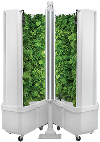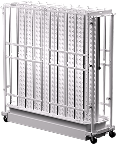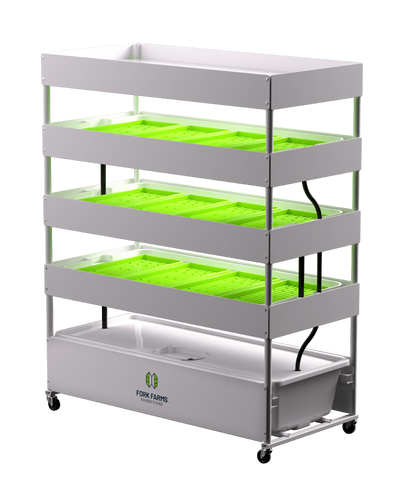Unleashing Success: Avoid Common Mistakes in Indoor Hydroponic Gardening
Indoor hydroponic gardens are an efficient method of cultivating plants without the need for traditional soil. In these controlled environments, plants are grown in nutrient-rich water solutions, with their roots suspended rather than in the ground. One of the key advantages of indoor hydroponic gardening lies in its ability to maximize space and resources, allowing for year-round cultivation and significantly higher yields compared to conventional soil-based gardening methods. Additionally, these gardens offer precise control over environmental factors such as lighting, humidity, and nutrient levels, promoting healthier plant growth and minimizing the risk of unsuccessful crops.
However, like any gardening method, it requires care and attention. Discover how overlooking essential factors like nutrient management, air circulation, and environmental conditions can impact your plants' well-being. It is important to have a comprehensive understanding of these common mistakes and how to avoid them. So, whether you're a novice grower or a seasoned enthusiast, join us as we delve into these mistakes and how to avoid them in your indoor hydroponic garden.
Is the Flex Farm right for you?
Connect with an expert member of our team and let’s work together to bring your growing experience to life.
1) Neglecting Proper Lighting
One of the fundamental requirements for plants to grow indoors is adequate lighting. Hydroponic gardeners make the mistake of underestimating the importance of light quality, duration, and intensity. Insufficient light can lead to stunted growth and poor yield. Invest in high-quality LED grow lights tailored to the specific needs of your plants. Regularly check the distance between the light source and your plants to prevent burns or insufficient light exposure. It is also important to make sure your plants are receiving the appropriate amount of light. At Fork Farms, we recommend having the light tower on for a minimum of 14 hours for most leafy greens.
2) Overlooking pH Levels:
Maintaining the correct pH level of the nutrient solution is crucial in hydroponic gardening. Plants have specific pH preferences, and deviations from the ideal range can lead to nutrient deficiencies. Regularly test and adjust the pH of your nutrient solution to match the requirements of your plants, ensuring they can absorb essential nutrients effectively. The majority of leafy greens need a pH level in the range of 5.5-7.5 with a target of 6.
3) Poor Nutrient Management:
Balanced nutrient solutions are central to healthy hydroponic gardens. Often hydroponic gardeners make the mistake of either overdosing or underdosing their plants. Both scenarios can harm plant health. Follow recommended guidelines for nutrient concentrations, and regularly monitor your plants for signs of nutrient imbalances such as discolored leaves or stunted growth. Adjust nutrient levels accordingly to promote healthy growth.
4) Inadequate Air Circulation:
Indoor environments can become stagnant, especially small enclosures, hindering proper airflow around plants. If this is happening, we recommend using oscillating fans to maintain consistent air movement within your indoor hydroponic garden. This not only helps the plants breathe (increasing their nutrient uptake but also strengthens plant stems, leading to more robust and healthier plants.
5) Ignoring Temperature and Humidity:
Temperature and humidity levels significantly impact plant growth. Many hydroponic gardeners overlook the importance of maintaining optimal environmental conditions. Different plants have varying temperature and humidity requirements, so it's essential to research the specific needs of your crops. We recommend maintaining humidity levels between 40-70% and temperatures between 60-80 degrees F for most plant varieties (leafy greens like spinach prefer a cooler environment). It might be a good idea to Invest in a thermometer to monitor and regulate the indoor climate for the best results.
6) Clogging and Disruptions in Waterflow:
Proper water flow is crucial for healthy plants in indoor hydroponic gardens. Neglecting to check water flow regularly and not adding sufficient nutrient-rich water as plants mature can lead to dry systems, causing wilting and damage to plants and water pumps. Clogged waterlines restrict nutrients and water supply, causing poor growth. To prevent these issues, establish a routine for checking, adding water, and cleaning waterlines. Swiftly identify and resolve clogs to maintain a thriving hydroponic garden.
Next Steps
In conclusion, successful indoor hydroponic gardening requires attention to detail and a proactive approach. Remember, each plant is unique, so understanding the specific requirements of your chosen crops is key to a flourishing indoor hydroponic garden.
By avoiding these common mistakes, you can create a thriving indoor hydroponic garden that grows an abundance of fresh food.
Visit our help center for more helpful tips on how to maintain a healthy indoor hydroponic garden.
If you already growing with the Flex Farm, visit Farmative for comprehensive troubleshooting guides and growing videos.
Important Links:
























